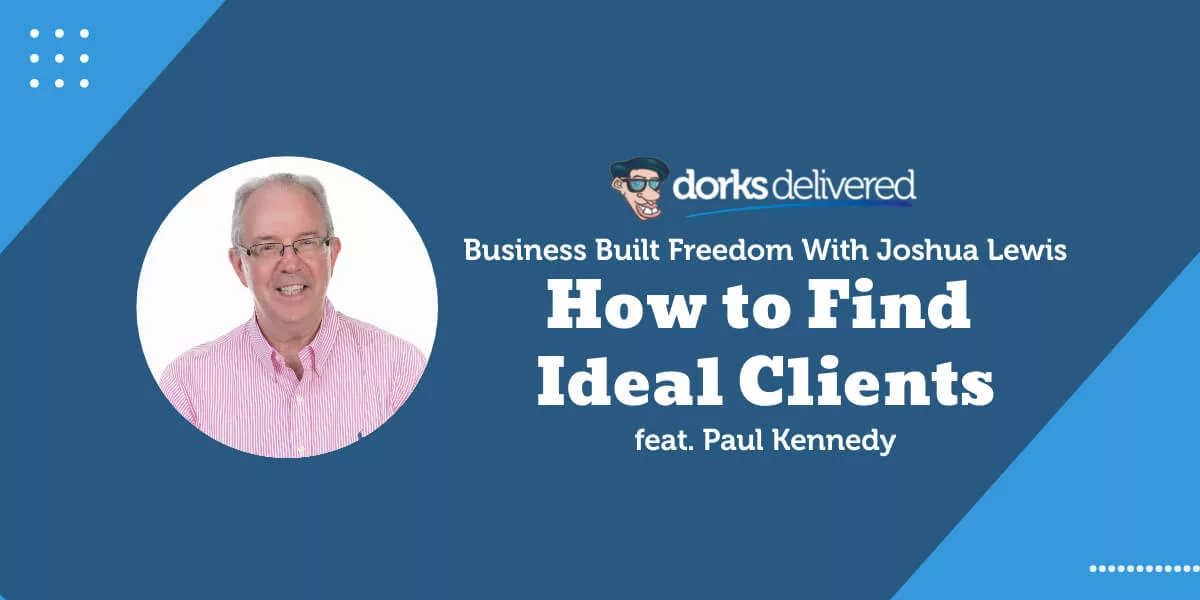Finding the ideal clients in business is an essential step in building a successful and profitable company. By identifying and targeting these ideal clients, you can focus your efforts and resources on the most promising prospects, increase your chances of closing sales, and build long-lasting, profitable relationships with your customers.
Paul Kennedy from PGV Consulting joined Josh to talk about all things regarding growing your client base.
How do you identify an ideal client?
Start With Your Why
Identifying your ideal clients start with the “why”. If you find out your “why”, your purpose, why you’re doing what you’re doing, it could be a mixture of both business aspirations and personal ones. Particularly if you’re self-employed, it’s good to blend the two because your personal life and your business life have to live in harmony with each other.
If you focus on your “why”, it gives you your passion as to why you’re really doing this. For instance, I’m an accountant by qualification. That doesn’t necessarily mean that I really want to do accounting, especially a few years down the track. My “Why” was not to be an accountant, and that kind of led me to where I am.
Working out your “why” makes the other questions—your “what”, “how”, “where”, and “When” so much easier. It’s like picking up the correct piece of the jigsaw first. Once you’ve done that, the rest of it follows much more easily.
Most of us meet and start off by asking, “what are you doing?” In my case, I’d perhaps start telling you about accounting, but it’s not where I really want to spend my time and perhaps not where other people want to spend theirs.
Who is your ideal client?
Identify the criteria and the things that make up your ideal client—the people who value, respect, and actually act on your advice.
A non-ideal client would be someone who neither respects, values, nor acts on your advice. They might still be paying you, but from your perspective, it would be very frustrating to give them your best advice but they do not actually act on it.
I wrote an article some time ago called ‘How to Find the Ideal Clients.’ If it’s of interest to any of your listeners, I’m very happy for them to have a copy. It was published in Spark Magazine about 4 years ago.
Read “How to Find the Ideal Clients” on LinkedIn
Nirvana: Ideal clients seek you out
I’ve got a few beliefs. One of them is Nirvana. It is when you get your business to the point where your ideal clients are actually seeking you out.
Once you’ve reached Nirvana, it means you’re in a very privileged position. If somebody is looking for somebody in your field and they know what you can do and what you’ve done for others, they will come to you and it won’t be all about price. It will be because they want Josh Lewis to look after their business, their IT. You change the relationship, and it becomes one where they want you. It’s not an argument or discussion over price.
Every business is unique. Ask a dork about technology for your business.
Think About Your Criteria
I encourage people to think through what the criteria of their ideal clients are. It is quite helpful to spend a bit of time identifying the traits of non-ideal clients.
I often encourage people to think of a situation they might have had where they won two clients, they’re driving home, and they’re pretty happy and excited. They’re particularly excited about winning Client A. They’re a bit lukewarm and cool about having Client B.
I encourage people to think through what were the traits of Client A that got you excited, and what were the traits of Client B that made you feel a bit cool about it (I’ve won them, but I’m not sure this is going to go the way I hope it does)? The more you can drill down on that, the more it will help you identify the clients you want and those you don’t want.
Should You Keep a Non-Ideal Client?
If you’ve just started in business, the expenses are being covered, and there’s food on the table, is it okay to stick with bad clients if removing them will mean that you’re no longer financially healthy?
Paul: We obviously need to be and want to be financially healthy. It perhaps comes down to timing as to how long you might bite your tongue and continue working with somebody who’s not an ideal client.
How do you deal with a non-ideal client?
All businesses need to be and want to be financially healthy. It perhaps comes down to timing as to how long you might bite your tongue and continue working with somebody who’s not an ideal client.
1. Think About Increasing the Price
Paul: All of us in business invariably have some clients that we perhaps don’t want. You can have a very direct conversation and say, ‘Look, perhaps I’m not the best person for you.’ We could do it by increasing your price to be unattractive to people who are not ideal clients.
If you really don’t believe that this is the sort of business you want to be working with a particular client, increasing your price so that you’re unattractive is one way of doing it.
2. Be Upfront
It’s not a bad idea to be even a bit more upfront and simply say, ‘I don’t think I’m the right person for you.’ When terminating a contract, I do it as pleasantly as possible. I think that we need to be honest, not everybody is going to work with everybody. Otherwise, you’d end up marrying everybody.
You can’t be everything to everybody. You shouldn’t try to be. If you do, you’d probably come to grief and a bit unstuck.
Turn your IT into a utility. Ask a dork about automating repetitive tasks.
3. Be Innovative
I also have a client with whom I’ve done quite a bit of work over the years. My role was to identify people that I knew that represented his or his company’s ideal client criteria and to introduce
In doing so, I was introducing my client to his prospective client, who loved what my client did, but because they were spread across Australia, it was just going to be prohibitive.
After I’ve done my initial introduction, my client and the prospective client sat down and talked it through. The latter said that they love what my client does—bringing our senior management together for a day and a half once a month for 10 months—but the cost is much more than they are prepared to pay and bringing together the senior management from across Australia once a month is really overwhelming for us.
This happened over five years ago, so I was a bit surprised that my client hadn’t thought of doing it by Zoom. Five years later, they are still doing business. The client is delighted. They’ve achieved it at a much lower rate, and they’ve managed to do it without disrupting their business every month when they bring a group of senior executives together.
It’s often not what you do. With my client, all they really changed was how they did it. I can’t really take the credit, but my client said that I have changed the criteria of their ideal client. They see themselves delivering what they do—business coaching—to a much larger audience than what they previously have perceived. I’m a great believer in knowing who your ideal clients are, who you would like them to be, and who they could be.
4. Look at the Good Side of Things
I think following the pandemic essentially everybody has recognised that we can do so much. What we were previously doing physically at one location we can actually do via Zoom. The pandemic accelerated much of the change that was going on.
Technology is your friend, and I’m learning that myself and enjoying working with people who have that outlook and have that ability, which I very much respect.
Boost your team’s productivity with the help of technology. Book your free consultation with a dork.
Make Your Ideal Clients Remember You
What I do is I work with my client in identifying a number of activities. They could be one-on-one introductions, giving presentations, writing articles, whatever’s right for my client so that we are constantly getting them in front of their ideal clients.
I think some people go way over the top. They’re excellent at what they do, but I think they significantly overcommunicate to the point where their target market is annoyed and say, ‘If I get another email from Paul Kennedy, I’ll scream.’ You don’t want to do that.
On the other hand, you don’t want to go to the other extreme where your target market says, ‘I’ve got an email from this guy Paul Kennedy, and I don’t think I even know him.’ You’ve got to be just right. It’ll be different for every business, but you have to make sure that when your ideal client has a need, you are the one they think of and they know how to contact you.
Build a Business Development and Marketing Calendar
Identify those five to eight activities and then build a marketing and business development calendar that bullet points down which activities you are going to do each month. They are all different because there is no single silver bullet. I don’t believe you could do it all via LinkedIn or do it all via one-on-one introduction. You need to be doing a variety of activities that are getting you in front of these ideal clients and you need to do it consistently, not just once.
Get yourself to the point where you’ve built your brand amongst your target markets or your ideal clients so that when the time is right for them, not when the time is right for you, they keep thinking, ‘I need to go and talk to Josh at Dorks Delivered.’
I’ve got an excellent database of people I know and who know me. Some of the people are so good at their social media, but personally, I think they do too much of it to the point where I have it set up so that it’s automatically put into a subfolder in their name because I respect what they do, but I physically cannot consume everything that they’re churning out. It could be one video a day and I just physically don’t have that time.
I think so much of that good content that they’re sending out goes to waste. In my case, it goes automatically into the subfolders. Sometimes I get to look at it, most of the time not. These people are so good at what they do, but it’s going to waste.
On the other hand, you have the extreme of people who don’t communicate at all. I think finding that right balance somewhere in the middle so that you’re there enough but not to the point where you are an annoyance, is the way to go.
Get custom IT solutions for your business. Book a free discovery session with a dork!
How do you avoid losing a prospective client?
Remain Professional at All Times
You don’t want to get to the point where the relationship has become casual and taken for granted. If there is an issue, either party might get reluctant to raise it because of the closeness so it festers away. Equally, if you do get too close or your relationship has become too entrenched with that one individual in the company, what happens if that person moves on and he’s no longer there?
It’s a fine line. On one hand, you obviously want the relationship to be a healthy one, a productive one that works cooperatively for all parties. It’s important to make sure that it always remains professional, but you don’t take each other for granted and that you deliver what you say you are going to deliver. Don’t get to the point where you’re essentially living in each other’s pockets. I think there is a dividing line and it’s important to keep that.
Planning, Growth, and Value

Planning
I like to begin with the business plan. Otherwise, it’s a bit like going and trying to put a house on a roof before you’ve put the foundations down. I see the business plan as being the foundation, and it’s important that you do that. As part of that process, you go through all the normal things like mission, vision, strengths, SWOT analysis and so on, but I really like to drill down on ideal clients and equally non-ideal clients.
Growth
If you’ve reached Nirvana, your ideal clients seek you out, sadly, non-ideal clients will also seek you out. When that happens, it’s always good to know your competitors. Refer your non-ideal clients to them. Anything that can slow a competitor down is possibly a good thing.
Work out what activities are going to engage you with those ideal clients on a consistent and ongoing basis so that they get to know you and particularly what you can do for them.
People can engage my time by booking me for a certain number of hours per month where I work with them initially on the plan, if they don’t have one, and then actually implementing the plan and particularly getting them in front of their ideal clients: people I know and who know me.
Value
I have a wonderful database that’s very up to date and very comprehensive. I go through that when I’m working with a client in my database to see who I know that meets my client’s ideal client criteria. And then we set about a series of activities, such as one-on-one introductions and presentations, so that one gets to learn the story of the other and see if they can do business together.
A person or an organisation might not necessarily be an ideal client themselves, but they may know your ideal client and be able to introduce you or where you work in partnership, alliances, etc. I’m also a great believer in that so long as it works for all the parties involved. You don’t really want to be doing work with people who are frustrating, not ideal, can’t pay your bill, don’t actually act on your advice.
Do anything you can do to avoid that so that you’re always working in your circle of people who do actually value what you’re about and actually act on it and are able and willing to pay for your services.
Talk to Paul Kennedy about your business. Jump onto PGV Consulting!
Turn your IT into a utility! Talk to a dork to find out how you can use technology to achieve your business goals.

































